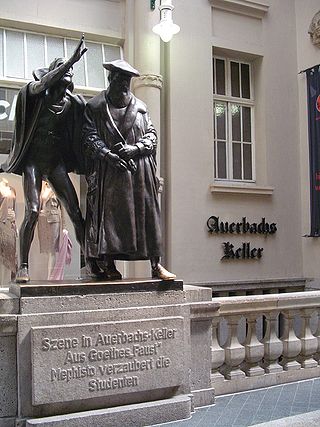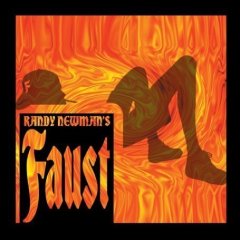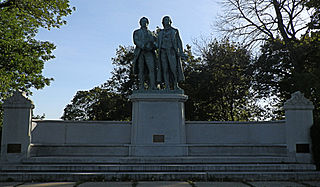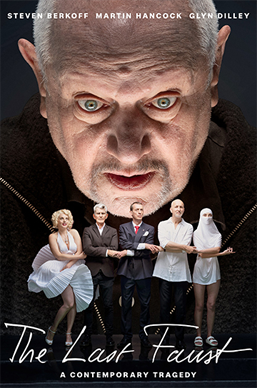Related Research Articles

A thyrsus /ˈθɜːrsəs/ or thyrsos /ˈθɜːrˌsɒs/ was a wand or staff of giant fennel covered with ivy vines and leaves, sometimes wound with taeniae and topped with a pine cone, artichoke, or by a bunch of vine-leaves and grapes or ivy-leaves and berries, carried during Hellenic festivals and religious ceremonies. The thyrsus is typically associated with the Greek god Dionysus, and represents a symbol of prosperity, fertility, and hedonism similarly to Dionysus.

Faust is the protagonist of a classic German legend based on the historical Johann Georg Faust.

Faust is a tragic play in two parts by Johann Wolfgang von Goethe, usually known in English as Faust, Part One and Faust, Part Two. Nearly all of Part One and the majority of Part Two are written in rhymed verse. Although rarely staged in its entirety, it is the play with the largest audience numbers on German-language stages. Faust is considered by many to be Goethe's magnum opus and the greatest work of German literature.

Faust: The Second Part of the Tragedy is the second part of the tragic play Faust by Johann Wolfgang von Goethe. It was published in 1832, the year of Goethe's death.

The Black Halo is the seventh studio album by American power metal band Kamelot. It was released on March 15, 2005, through Steamhammer Records. It is a concept album inspired by Goethe's Faust. Continuing the story introduced in Epica (2003), it is the second and final record in Kamelot's two-part rock opera about Ariel. Epica tells Part 1 while The Black Halo tells Part 2. Goethe's Faust is also broken into two parts. The Black Halo features guest appearances by Simone Simons (Epica), Shagrath, Jens Johansson (Stratovarius), and several others. The album was released on vinyl in the spring of 2009, along with Ghost Opera (2007).

"Gretchen am Spinnrade", Op. 2, D 118, is a Lied composed by Franz Schubert using the text from Part One, scene 15 of Johann Wolfgang von Goethe's Faust. With "Gretchen am Spinnrade" and some 600 other songs for voice and piano, Schubert contributed transformatively to the genre of Lied. "Gretchen am Spinnrade" was composed for soprano voice but has been transposed to accommodate other voice types. Schubert composed "Gretchen am Spinnrade" on 19 October 1814, three months before his eighteenth birthday.
A Faust Symphony in three character pictures, S.108, or simply the "Faust Symphony", is a choral symphony written by Hungarian composer Franz Liszt inspired by Johann Wolfgang von Goethe's drama, Faust. The symphony was premiered in Weimar on 5 September 1857, for the inauguration of the Goethe–Schiller Monument there.

Randy Newman's Faust is the ninth studio album and a 1995 musical by American musician and songwriter Randy Newman, who based the work on the classic story of Faust, borrowing elements from the version by Goethe, as well as Milton's Paradise Lost, but updating the story to the modern day, and infusing it with humorous cynicism.

Anna Swanwick was an English author and feminist.
The Romantic hero is a literary archetype referring to a character that rejects established norms and conventions, has been rejected by society, and has themselves at the center of their own existence. The Romantic hero is often the protagonist in a literary work, and the primary focus is on the character's thoughts rather than their actions.
Faust has inspired artistic and cultural works for over four centuries. The following lists cover various media to include items of historic interest, enduring works of high art, and recent representations in popular culture. The entries represent works that a reader has a reasonable chance of encountering rather than a complete catalog.

La Beauté du diable is a 1950 Franco-Italian fantasy film drama directed by René Clair. A tragicomedy set in the early 19th century, it is about an ageing alchemist, Henri Faust, who is given the chance to be eternally young by the devil Mephistopheles. It is loosely adapted from the classic early 19th-century verse play Faust by Johann Wolfgang von Goethe.

Faust is a series of approximately 100 paintings created between 1976 and 1979 by Nabil Kanso. The paintings depict figural compositions in a sequence of scenes whose subjects are loosely based on Goethe’s 1808 play Faust Part One and Part Two.

Johann Wolfgang (von) Goethe was a German poet, playwright, novelist, scientist, statesman, theatre director, and critic. His works include plays, poetry, literature, and aesthetic criticism, as well as treatises on botany, anatomy, and color. He is widely regarded as the greatest and most influential writer in the German language, and his work has had a profound and wide-ranging influence on Western literary, political, and philosophical thought from the late 18th century to the present day.

The Goethe–Schiller Monument is a public artwork by German artist Ernst Friedrich August Rietschel located in Washington Park, which is in Milwaukee, Wisconsin, United States. The bronze sculpture from 1908 depicts two men, Johann Wolfgang von Goethe and Friedrich von Schiller, one holding a laurel wreath and the other a scroll. The 12 foot artwork rests upon a 26 foot long granite base. The bronze sculpture is a recasting of the statue incorporated into the 1857 Goethe-Schiller Monument in Weimar, Germany.

Faustus, the Last Night is an opera in English by French composer Pascal Dusapin, inspired by Doctor Faustus by Christopher Marlowe. The work was premiered on 21 January 2006 by the Berlin State Opera, a coproduction with the Opéra de Lyon. It was first staged in the United States at the Spoleto Festival USA 2007.

Le petit Faust is an opéra bouffe in four acts which burlesques the drama Faust by Goethe and the opera of the same name by Gounod. The music of the piece is by Hervé, with a text by Hector-Jonathan Crémieux and Adolphe Jaime. The work had its premiere in Paris at the Théâtre des Folies-Dramatiques on 23 April 1869.
The Magic Flute Part Two is a fragmentary closet libretto by Johann Wolfgang von Goethe, which is inspired by Mozart's The Magic Flute. Parts were published in 1802 by Friedrich Wilmans, but its final form was published by Goethe in 1807.
Heinrich Edmund Karl Henel was the Sterling Professor Emeritus of German at Yale University.

The Last Faust is a 2019 feature art film written and directed by the German artist Philipp Humm. Set in 2059, it is a contemporary interpretation of Johann Wolfgang von Goethe's 1808 Faust and the first film directly based on both parts of the tragedy. It stars English actors Steven Berkoff and, Martin Hancock (Faust). Its music is based on Richard Wagner with tracks from Swiss electronic music duo Yello.
References
- ↑ "Jane K. Brown". washington.edu. Retrieved May 13, 2017.
- ↑ "Book". upenn.edu. Retrieved May 13, 2017.